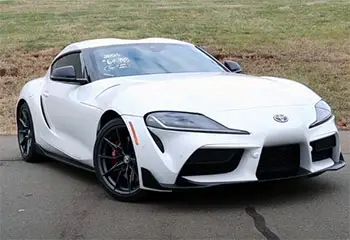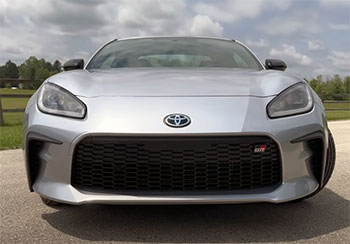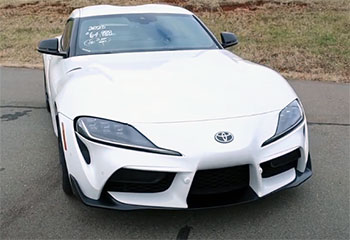I’ve always been a car enthusiast, drawn to the thrill of a well-tuned engine and the joy of a tight corner. When it came to choosing between the Toyota Supra and the Toyota GT86, I found myself torn between two iconic sports cars that embody Toyota’s performance spirit in different ways.
In this article, I’ll share my firsthand experience comparing these two vehicles, breaking down their key features, performance, and driving dynamics. Whether you’re chasing raw power or pure driving fun, I’ll help you decide which Toyota sports car suits your style.
Comparison Table: Toyota Supra Vs. Toyota GT86
| Feature | Toyota Supra (2023 GR Supra) | Toyota GT86 (2023 GR86) |
|---|---|---|
| Base Price (MSRP) | $44,640 (2.0L) / $57,650 (3.0L) | $28,400 |
| Engine | 2.0L Turbo I4 (255 hp) / 3.0L Turbo I6 (382 hp) | 2.4L Naturally Aspirated Boxer-4 (228 hp) |
| Transmission | 8-speed Auto / 6-speed Manual (3.0L only) | 6-speed Manual / 6-speed Auto |
| 0-60 mph | 5.0 sec (2.0L) / 3.9 sec (3.0L) | 6.1 sec (Manual) |
| Fuel Economy | 25/32 mpg (2.0L) / 22/30 mpg (3.0L) | 20/27 mpg (Manual) |
| Weight | 3,181 lbs (2.0L) / 3,400 lbs (3.0L) | 2,817 lbs |
| Cargo Space | 10.2 cu ft | 6.3 cu ft |
| Seating | 2 seats | 2+2 (rear seats minimal) |
| Drivetrain | Rear-Wheel Drive | Rear-Wheel Drive |
My Experience With the Toyota Supra

Driving the 2023 Toyota GR Supra felt like stepping into a modern legend. The Supra name carries weight, evoking memories of the iconic MkIV from the ‘90s, and this fifth-generation model (A90) lives up to that heritage with a sleek design and potent performance.
Developed in collaboration with BMW, the Supra shares its platform with the Z4, but Toyota’s Gazoo Racing (GR) division gave it a distinct character.
I tested both the 2.0L four-cylinder and 3.0L six-cylinder versions, and each offered a unique driving experience.
The Supra’s exterior is a head-turner. Its low, wide stance, sharp creases, and aggressive vents scream performance.
Inside, the cabin feels like a cockpit, with BMW-sourced switchgear and a snug, driver-focused layout.
The 3.0L inline-six, producing 382 horsepower, delivered a surge of power that pinned me to the seat, especially on highways where its 0-60 mph sprint of 3.9 seconds shone. The 2.0L version, with 255 horsepower, wasn’t as explosive but still felt quick, hitting 60 mph in 5.0 seconds.
The eight-speed automatic is smooth and responsive, but the six-speed manual (available on the 3.0L) added a layer of engagement, with crisp shifts and rev-matching that made every gear change a joy.
Handling is where the Supra excels. Its adaptive suspension and active rear differential make it a corner-carving machine, though the 2.0L’s softer tuning leans more toward comfort. On twisty backroads, the Supra felt planted, with precise steering that let me place it exactly where I wanted. However, the ride can feel stiff in the 3.0L, especially in Sport mode, and the low ground clearance demands caution on rough roads.
The cabin, while premium, lacks the rear seats of its predecessor, limiting practicality. Still, the 10.2 cubic feet of cargo space was enough for my weekend gear, and the Supra’s fuel efficiency (22/30 mpg for the 3.0L) surprised me for a car this powerful.
Pros Of the Toyota Supra
- Powerful Engine Options: The 3.0L inline-six delivers 382 horsepower and 368 lb-ft of torque, making it a beast for straight-line speed. Even the 2.0L’s 255 horsepower feels punchy for daily driving.
- Sharp Handling: The Supra’s sport-tuned suspension, active differential, and near-perfect weight distribution make it a joy in corners, rivaling more expensive sports cars.
- Manual Transmission Option: The six-speed manual on the 3.0L adds driver engagement, with smooth shifts and automatic rev-matching for effortless downshifts.
- Premium Interior: The BMW-sourced cabin feels upscale, with supportive seats, a 10-speaker audio system, and intuitive controls that elevate the driving experience.
- Striking Design: The Supra’s futuristic styling, with its low profile and aggressive lines, turns heads everywhere, making it feel like a supercar on a budget.
- Fuel Efficiency: At 25/32 mpg (2.0L) and 22/30 mpg (3.0L), the Supra balances performance with reasonable fuel economy for a sports car.
Read More: My Thoughts On Ford Escape Vs. Mazda CX-5
Cons Of the Toyota Supra
- Limited Practicality: With only two seats and no rear storage wall, the Supra isn’t ideal for carrying passengers or securing cargo for longer trips.
- Stiff Ride in 3.0L: The sport-tuned suspension, especially in the 3.0L, can feel harsh on bumpy roads, making daily commutes less comfortable.
- BMW Influence: Purists may dislike the heavy BMW DNA, from the B58 engine to the iDrive infotainment, which dilutes the Toyota heritage.
- Expensive Base Price: Starting at $44,640 for the 2.0L and $57,650 for the 3.0L, the Supra is significantly pricier than the GT86, limiting affordability.
- No Manual for 2.0L: The four-cylinder Supra is automatic-only, which may disappoint enthusiasts seeking a more engaging drive.
- Low Ground Clearance: The Supra’s low stance looks great but requires caution over speed bumps and uneven surfaces to avoid scraping.
My Experience With the Toyota GT86

The 2023 Toyota GR86, the second generation of the 86, is a love letter to driving purists. Built in collaboration with Subaru (sharing its platform with the BRZ), the GR86 refines the original’s formula of affordable, rear-wheel-drive fun.
I spent a week behind the wheel of the manual version, and it reminded me why simple, lightweight sports cars are so addictive.
The GR86’s design is sleek yet understated, with a low bonnet, angled headlights, and a ducktail spoiler that nods to the AE86 of drifting fame.
Its 2.4L boxer-four engine, producing 228 horsepower and 184 lb-ft of torque, isn’t a powerhouse, but the car’s 2,817-pound curb weight makes it feel lively.
The 0-60 mph time of 6.1 seconds won’t win drag races, but the GR86 shines on twisty roads. Its suspension, tuned by Gazoo Racing, is stiff yet forgiving, and the TORSEN limited-slip differential ensures excellent grip. The six-speed manual gearbox is a highlight, with short, precise throws that make every shift rewarding.
Inside, the GR86 is spartan but functional. The cloth seats are comfortable, and the steering wheel feels perfect in hand, but the infotainment system is basic, and the rear seats are more decorative than usable. The 6.3 cubic feet of cargo space is tight, barely fitting a small suitcase.
On the road, the GR86’s low center of gravity and responsive steering made it feel like an extension of my body, especially in corners where I could easily induce controlled oversteer. However, the engine’s lack of low-end torque meant I had to keep revs high, and road noise was noticeable on highways. Still, at $28,400, the GR86 delivers unmatched fun for the price.
Pros Of the Toyota GT86
- Affordable Price: Starting at $28,400, the GR86 is one of the most accessible sports cars, offering incredible value for enthusiasts.
- Nimble Handling: Its lightweight chassis, low center of gravity, and GR-tuned suspension make it a cornering champion, perfect for spirited drives.
- Engaging Manual Gearbox: The six-speed manual is precise and fun, encouraging drivers to stay engaged with every shift.
- Customization Potential: The GR86’s aftermarket support is vast, with affordable parts for performance upgrades or aesthetic tweaks.
- Classic Sports Car Feel: The naturally aspirated engine and analog driving dynamics deliver a raw, connected experience that’s rare today.
- Reliable Platform: Built with Subaru, the GR86 inherits Toyota’s reputation for durability, making it a practical daily driver.
Cons Of the Toyota GT86
- Underpowered Engine: The 228-horsepower boxer-four lacks low-end torque, requiring high revs to extract performance, which can feel underwhelming.
- Minimalist Interior: The cabin is basic, with cloth seats, a simple infotainment system, and limited tech compared to the Supra.
- Limited Cargo Space: With only 6.3 cubic feet of trunk space, the GR86 struggles to accommodate anything beyond small bags.
- Rear Seat Practicality: The 2+2 layout is cramped, with rear seats suitable only for small children or extra storage.
- Road Noise: The lightweight construction and stiff suspension amplify road and tire noise, especially on long highway drives.
- No Turbo Option: Unlike the Supra, the GR86 lacks a turbocharged variant, limiting its straight-line speed potential.
Head-to-Head: Performance and Driving Dynamics

Let’s break down how these cars stack up in real-world driving.
The Supra, especially the 3.0L, is the clear winner in raw performance. Its 382 horsepower and 368 lb-ft of torque make it a highway king, effortlessly merging or overtaking with a throaty exhaust note.
The 2.0L Supra, while less intense, still outpaces the GR86, thanks to its turbocharged 255 horsepower.
The Supra’s eight-speed automatic is quick and smooth, but the manual option (3.0L only) elevates the experience, especially on backroads where precise gear changes add to the fun.
The GR86, however, is all about finesse. Its 228 horsepower and 184 lb-ft of torque don’t sound impressive, but the car’s lightweight chassis makes it feel quicker than the numbers suggest. The boxer-four engine requires you to work the revs, peaking at 7,000 rpm, which feels rewarding but demands effort.
The GR86’s handling is its trump card. On a winding mountain road, I found myself grinning as I flicked it through corners, the rear end playfully stepping out with a nudge of throttle. The Supra handles well too, but its heavier weight (3,181 lbs for the 2.0L, 3,400 lbs for the 3.0L) makes it less agile than the 2,817-pound GR86.
In terms of ride quality, the Supra 2.0L offers a more comfortable daily driving experience due to its softer suspension, while the 3.0L’s stiffer setup prioritizes performance. The GR86’s suspension is tuned for sharpness, which makes it feel alive but can be jarring on rough roads. For daily commutes, the Supra’s quieter cabin and better fuel economy (25/32 mpg vs. 20/27 mpg) give it an edge, especially for highway-heavy drives. However, the GR86’s lower price and nimble nature make it more approachable for enthusiasts on a budget.
Design and Aesthetics
The Supra’s design is bold and futuristic, with a long hood, sculpted sides, and a low, aggressive stance. It looks like it belongs in a sci-fi movie, and its 19-inch wheels (18-inch on the 2.0L) add to the premium feel. The GR86, by contrast, has a more classic sports car look, with a sleek roofline and subtle curves that echo the AE86. Its 17-inch wheels (18-inch on higher trims) are less flashy but suit its understated vibe. Both cars turn heads, but the Supra feels like a statement, while the GR86 is a nod to purists.
Inside, the Supra’s cabin is a step above, with leather and synthetic suede seats, a 10-speaker audio system, and BMW’s iDrive infotainment, which is intuitive but not distinctly Toyota. The GR86’s interior is functional, with cloth seats and a basic 6-speaker system. It prioritizes driving over luxury, which I appreciated for its honesty but found lacking in refinement. The Supra’s lack of rear seats limits versatility, while the GR86’s tiny back seats are more symbolic than practical.
Practicality and Ownership
For daily driving, both cars have compromises. The Supra’s 10.2 cubic feet of cargo space is decent for a sports car, easily swallowing a week’s groceries or a weekend bag. The GR86’s 6.3 cubic feet is tight, barely fitting a small suitcase. Neither car is ideal for families, but the GR86’s 2+2 layout offers slight flexibility for small passengers or extra storage. Fuel economy favors the Supra, especially the 2.0L, which achieves 25/32 mpg compared to the GR86’s 20/27 mpg. Maintenance costs are higher for the Supra due to its premium components, while the GR86 benefits from affordable parts and strong aftermarket support.
The Supra’s starting price of $44,640 (2.0L) or $57,650 (3.0L) makes it a significant investment, while the GR86’s $28,400 base price is a steal for a sports car. Resale value is another factor: the GR86 retains 76.6% of its value after five years, compared to the Supra’s 64%, making the GR86 a better long-term investment. Both cars benefit from Toyota’s reliability, but the Supra’s BMW-sourced engine may raise concerns about long-term maintenance compared to the GR86’s Subaru-built powertrain.
Which Is Right for You?
Choosing between the Supra and GR86 depends on your priorities. If you crave raw power, premium features, and a car that feels like a mini-supercar, the Supra is your pick. Its turbocharged engines, sharp handling, and upscale interior make it ideal for those who want performance with a touch of luxury. However, its higher price and stiffer ride may deter budget-conscious buyers or those seeking a pure, analog experience.
The GR86, on the other hand, is the enthusiast’s choice. Its lightweight chassis, precise handling, and affordable price make it a driver’s car through and through. It’s less practical and less powerful, but its raw, connected feel is unmatched for the price. If you love wringing out every ounce of performance on a twisty road, the GR86 will leave you smiling.
Read More: My Thoughts On Acura MDX Vs. Lexus GX
Frequently Asked Questions (FAQ)
No, the GT86 (GR86) and Supra are distinct sports cars. The GR86 is a lightweight, affordable coupe with a Subaru-sourced boxer-four engine, while the Supra is a pricier, more powerful sports car with BMW-sourced turbocharged engines.
The Supra offers turbocharged four- or six-cylinder engines (255 or 382 hp), a premium interior, and a two-seat layout, starting at $44,640. The GR86 has a 228-hp naturally aspirated boxer-four, a simpler interior, and a 2+2 layout, starting at $28,400.
The Supra is faster, with the 3.0L hitting 0-60 mph in 3.9 seconds and the 2.0L in 5.0 seconds. The GR86 takes 6.1 seconds but feels quicker in corners due to its lighter weight.
The Supra (3.0L) offers 382 hp and better fuel economy (22/30 mpg) at a lower price ($57,650) than the GTR ($121,090), which has 565 hp and all-wheel drive. The GTR is faster (0-60 in ~3 seconds) but less practical. The Supra is better for budget-conscious enthusiasts; the GTR suits those seeking ultimate performance.
Conclusion: For Toyota Supra and GT86
You’ve got a tough choice ahead, but it’s a good one. If you’re after a car that blends power, style, and a touch of luxury, the Toyota Supra will thrill you with its turbocharged engines and track-ready handling. It’s perfect if you want a sports car that feels special every day, though you’ll pay a premium for it. If your heart is set on pure, unfiltered driving joy on a budget, the Toyota GT86 (GR86) is your match. Its lightweight design and engaging dynamics make every drive an adventure. Test drive both—you’ll know which one speaks to you.

